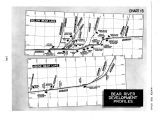| OCR Text |
Show WATER FOR UTAH five urgency to provide for national security and dispersion of industry, may make it reasonable to anticipate the potential establishment of production units in the Green River area on the scale of 300,000 barrels of synthetic liquid fuels per day. However, adequate water supplies and dependable power sources are a major consideration in such establishment. Without them serious delays will be experienced, and it may become necessary to ship Utah's coal long and costly distances to plants more suitably provided with wafer and electrical power. It is estimated that economic plant units for synthetic liquid fuel production from Utah's coals would manufacture 30,000 barrels per day. Each such plant unit would require 5,400,000 tons of coal per year, representing the output of a minimum of 2000 coal miners. Plant operations would require another 1500 men. The total labor force and supporting services for each plant would constitute a community of 15,000 persons. The water required for processing, for cooling and for culinary purposes for each such plant unit would total some 7,000,000,000 gallons per year, or the equivalent minimum of 22,000 acre- feet per year, for all consumptive uses. Power consumption of such a unit would range between 275 to 500 million kilowatt- hours annually. Therefore, if it becomes necessary - and there is little question as to the need - to install ten such units in the Green River Basin, the total water and power requirements would be on the order of 220,000 to 300,000 acre- feet per year, and between 2.75 and 5 billion kilowatt- hours annually. The consequent population concentration in that area would total 150,000 persons. OIL AND RELATED PRODUCTS Utah's oil reserves are locked up in its shales, bituminous sandstones and coal deposits. However, production from proven oil fields in neighboring states is refined to a major extent in Utah. Considerable drilling and exploration is in progress. As these fields expand production, and new pipe lines are constructed to refining points in Utah, the need for enlargement of these refineries will grow, with consequent increase in water and power requirements. It is estimated that oil refining requires, per 10,000 gallon- production, between 200,000 to 300,000 gallons of water and a relatively small amount of electric power, on the order of 20 to 75 kilowatt- hours. In the refining of crude petroleum into its higher- value distillates, a certain amount of carbon results, known as petroleum coke. Prior to the war, there had been a tendency to avoid the production of this coke; today, the demands for it are causing a change in these trends. The highly desirable characteristics of this coke for electro- process industries - its unusually high fixed carbon content and its compact physical grain - make it almost the sole material utilized in the production of carbon electrodes for electric furnaces and for cell lining in such industries as aluminum reduction. The importance of carbon for these purposes is exemplified below: ELECTRODE CONSUMPTION IN CERTAIN MAJOR ELECTRO- PROCESS INDUSTRIES ( Pounds per Ton Produced) Aluminum 1,500 Magnesium 1,400 Calcium carbide 50 Ferrochrome 60 Ferromanganese 85 Ferrosilicon 65 Phosphorus 38 Iron smelting 20 Electric steel 15 The requirements for the products of these industries, it has been pointed out, are compounding rapidly. Recent estimates for aluminum alone indicate a growth from 300 million pounds of production prior to the war to approximately 2 billion pounds at present. The amazing expansion of markets for this metal indicates clearly the need for further expansion, perhaps to between 4 billion and 7 billion pounds by 1960. The Pacific Northwest, it is thought, will share this possible expansion to a probable 2 to 3 billion pounds. The total carbon requirements would range between 600,000 and 1,000,000 tons of combined petroleum coke and other carbonaceous binders. Utah's potential petroleum coke production and that of " super" coke ( produced from high quality coking coals from which ash is removed by leaching and flotation) could be drawn upon to a major extent. In addition, the availability of petroleum coke, coal tars and [ 80] |

















































































































































